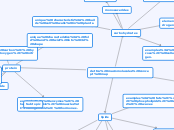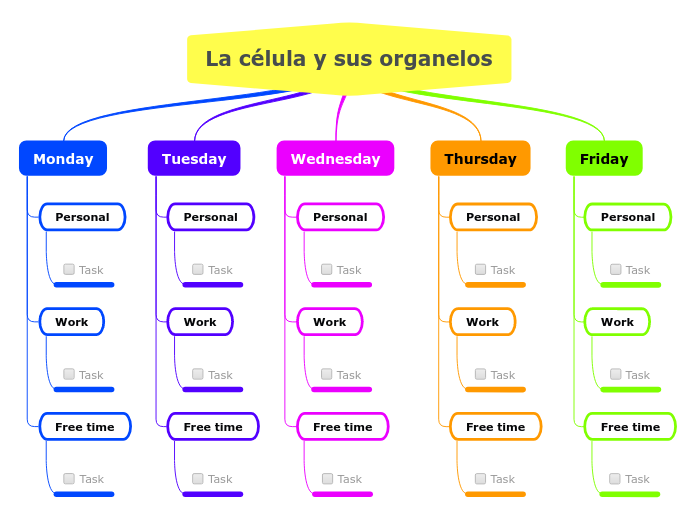إعداد: معاذ بن سعد العساف
A tour of the cell
Extracellular Components
Extracellular Matrix ( ECM )
The ECM is made up of Collagen Fibers, which
(2)Protects the plasma membrane.
(1)holds cells together.
Animal cells lack cell walls, but covered by Extracellular Matrix ( ECM ).
Cell Walls
In plant cells
Plasmodesmata, the structure that connect two adjacent cells together.
Plant cell walls my have multiple layers :-
3- Secondary cell wall : thick layer between plasma membrane and the primary cell wall.
In some cells.
Like ( Wood )
2- Middle Lamella : then layer between primary walls of 2 adjacent cells.
1- Primary cell wall : relativity then and flexible.
Which allows the growing cell to continue to enlarging.
Plant cell walls are made of :-
3- Proteins.
2- Polysaccharides.
1- Mainly of cellulose.
The cell wall protect the plant cell, maintains its shape.
Cell Wall distinguishes plant cells from animal cells.
Cilia and Flagella
Compare between Cilia and Flagella
Both cilia and flagella are made of microtubeles.
Cilia and Flagella ( Paramecium )
Microtubeles cause cilia anf flagella to move.
Energy-Converting Oranelles
Chloroplasts
In plant cells
The compartments inside the inner membrane :-
3- Granum, is each stack of thylakoids. ( plural = Grana ).
- the sites where the green chlorophyll molecules embedded in thylakoid membranes trap solar energy.
- Grana is the chloroplast's solar power packs.
2- Thylakoids, is a network of interconnected sacs.
1- Stroma, is a thick fluid which contain chloroplasts DNA and Ribosomes and many enzymes.
Photosynthesis, the conversion of light energy from the sun to chemical energy of sugar molecules.
Chloroplasts are the photosynthesizing organelles of all photosynthetic eukaryotic.
Chloroplasts convert solar energy to chemical energy.
The Common things between Mitochondria and Chloroplasts :-
Contain their own DNA.
Both have a matrix.
They have a double membrane ( inner and outer ).
in between space called inner membrane space.
They are not part of the endomembrane system.
Mitochondria
In all eukaryotic cells
The mitochondrion has two internal compartments :-
2- The mitochondrial matrix. ( which contain )
2- Many enzymes, that catalyze some of the reactions of cellular respiration.
1- Mitochondrial DNA and Ribosomes.
1- The intermembrane space.
The narrow region between the inner and the outer membranes.
The Folds called cristea, increase the membrane's surface area, enhancing the mitochondrion's ability to produce ATP.
The inner membrane is highly folded and contain many embedded proteins molecules that function in ATP synthesis.
It enclosed by two membranes, composed of
2- Unique collection of Protein.
1- Phospholipids bilayer.
ATP is the main energy source for cellular work.
ATP = Adenosine Triphosphate.
The chemical energy of the molecule called ATP.
Converting the chemical energy of foods ( as sugar ) to the chemical energy.
Mitochondria are organelles that carry out cellular respiration.
nearly in all eukaryotic cells.
The endomembrane system
in Eukaryoric cells
Components of the Endo-Membrane system
Golgi Apparatus
Shipping and Receiving Center
Watch (1:30 - 3:50) Golgi
Various Golgi enzymes modify the carbohydrates protein of the glycoprotiens made in the ER.
How? Removing some sugars and substituting others.
Functions of Golgi Apparatus
2- Receive and Pack materials into transport vesicles.
1- Modifies Products ( Protein + lipids ) of the ER.
Note that: The flattened Golgi sacs are not connected. ( as are ER sacs ).
After leaving the ER, many transport vesicle travel to the Golgi Apparatus.
A cell may contain many, even hundreds of these stacks ( stack of flattened sacs ).
Consist of flattened membranous sacs.
Endoplasmic Reticulum
There are two distinct regions of ER
Smooth and Rough ER
2- Rough ER: with ribosomes attaching its surface.
An important synthesis in the book page 43 ( Figure 3.6B ).
The vesicle buds off the Rough ER membrane.
The vesicle now carries the protein to the Golgi Apparatus.
Transport Vesicle, a vesicle that moves from one part of the cell to another.
Short chains of sugars are often linked to the polypeptide, making the molecule a glycoprotein.
The polypeptide is synthesized by a bound ribosome following the instruction of an mRNA.
3- A membrane factory for the cell.
2- Distribution of manufactured proteins.
1- Makes additional membrane.
1- Smooth ER: witch lacks ribosomes.
Functions
* Our liver cells have large amounts of smooth ER.
4- Stores calcium ions.
3- Detoxifies poison.
2- Metabolizes carbohydrates.
1- Synthesizes lipids.
One of the major manufacturing sites in a cell is The Endoplasmic Reticulum.
The endoplasmic reticulum (ER) accounts for more than half of the total membrane in many eukaryotic cells.
Nuclear Envelope
Ribosomes ( Protein Factories )
From DNA to Protein
Some ribosomes are
Free and Bound Ribosomes
Bound (bound ribosomes) attached to the endoplasmic reticulum or the nuclear envelope.
Free (free ribosomes) suspended in cytoplasm
Cells that make a lot of proteins have a large number of ribosomes.
Ribosomes carry out protein synthesis.
Ribosomes are synthesized in the nucleolus, which is found in the nucleus.
Ribosomes are particles made of ribosomal RNA(rRNA) and protein.
The nucleolus is located within the nucleus.
and the site of ribosomal RNA (rRNA) synthesis.
When cell is not dividing, this chromosome called chromatin.
The Protein helps organize and coil the long DNA molecule.
The DNA is associated with many proteins in the structures called Chromosomes.
chromatin ti chromosome
Chromatin condenses to form Chromosomes.
In the nucleus: DNA + Protein form Genetic Material called Chromatin.
The nucleus contain most of DNA.
The nucleus control cell activities.
By directing protein synthesis.
The nucleus envelope controls the flow of materials into and out of the nucleus.
Nuclear envelope is a double membrane; each consist of a lipid bilayer ( double layer ).
Double Membrane
lipid bilayer
The nuclear envelope encloses the nucleus.
Plasma membrane
Plasma membrane structure
The general structure of a biological membrane is a double layer (bilayer) of
3- Carbohydrates.
2- Protein.
1- Phospholipids.
is selective barrier that
Drive out Wastes ( from cell ).
allows passage of Oxygen and Nutrients ( to cell ).
These membranes divide the cell into Functional and Structural compartment (or Organelles).
Composed of Different membranes that are suspended in the cytoplasm within aneukaryotic cell.
Cells
Prokaryotic, Eukaryotic,
Eukaryotic
Eukaryotic Common Properties
The structures and organelles of eukaryotic cells can be
organized into four basic functional groups as follows.
4- Structural support, movement, and communication among cells are the functions of components of the cytoskeleton, plasma membrane, and cell wall.
3- Mitochondria in all cells and chloroplasts in plant cells are involved in energy processing.
2- Organelles involved in breakdown or hydrolysis of molecules include lysosomes, vacuoles, and peroxisomes.
1- The nucleus and ribosomes carry out the genetic control the cell.
4- Each organelles is bounded by a membrane with a lipid and protein composition that suits its function.
3- Much larger than Prokaryotic.
2- Membrane-bound organelles.
1- DNA in a nucleus that is bounded by a membranous nuclear envelope.
Plant Cell
Peroxisomes
Organelles in Plant and Animal cells
Its Function is
Break down fatty acids to be used as cellular fuel.
Detoxifying harmful compounds and making hydrogen peroxide (H2O2) By-product.
(H2O2) confined with in peroxisomes then converted to (H2O) by resident enzymes.
Peroxisomes are metabolic compartments that don't originate from the endomembrane system.
Vacuole
Maintenance of the cell
It also stockpiles vital chemicals and acts as a trash can.
Large central vacuole, which helps the cell grow in size by absorbing water and enlarging.
Paramecium has two contractile vacuoles.
Vacuoles are large vesicles that have a variety of functions.
Planet cells have Plasmodesmata are cytoplasmic channels
through cell walls that connect adjacent cells.
Cell walls protect cells and help maintain their shape.
* Planet cells have a rigid rather than thick cell wall.
( Fungi and many protists have rigid )
Planet cells have ( Cell wall & Chloroplasts & Central Vacuole ).
Animal Cell
Lysosomes
Digestive Compartment
In Tay-Sachs disease, for example, a lipid digesting enzyme is missing, and the brain cells become impaired by an accumulation of lipids.
The lysosomes become engorged with undigested material,
eventually interfering with cellular function.
The cells of people with inherited lysosomal storage diseases lack one or more lysosomal enzymes.
Also, use enzymes to recycle the cell's organelles.
It can digest marcomolecules such as
Nucleic Acids
Polysaccharides
Fats
Proteins
The nutrients are then released into the cell fluid.
Lysosomes fuse with food vacuoles and digest the food.
Many proteins engulf food particles into membranous sacs called food vacuoles.
With the help of lysosomes a cell continually renews itself.
A lysosome provides an acidic environment for its enzymes.
The enzymes and membranes of lysosomes are made by
Rough ER and processed in the Golgi apparatus.
A lysosome is a membranous sac of hydrolytic enzymes.
Lysosomes are digestive compartments within a cell.
Animal cells have ( Lysosomes & Centrioles ).
Prokaryotic
* Only organisms of Domain Bacteria and Archaea.
6- Flagella: locomotion organelles of some bacteria.
5- Cell wall: rigid structure outside the plasma membrane.
4- The ribosomes smaller and differ somewhat from Eukaryotes.
3- No membrane-bound organelles.
2- DNA in an unbounded region called Nucleoid.
1- No nucleus.
All cells have several basic features in commen
4- The interior of both types of cell is called the cytoplasm.
3- Contain Ribosomes, tiny structures that make proteins according to instructions from the genes.
2- Have one or more Chromosomes, carrying genes made of DNA.
1- Bounded by a plasma membrane.
How cells can be seen ?!
The quality of an image depends on
3- Contrast, visible differences in parts of the sample.
2- Resolution, the measure of the clarity of the image, or the minimum distance of two distinguishable points.
1- Magnification, the ratio of an object’s image size to its real size.
* Most cells are between 1 and 100 micrometers.
Electron Microscopes ( EMs )
Two types of EM
Transmission Electron Microscope ( TEMs )
TEMs ( Paramecium )
Used to study the cell internal structure.
Focus a beam of electrons through a specimen.
Scanning Electron Microscope ( SEMs )
SEMs ( Paramecium )
Providing image that look 3D.
Focus a beam of electrons onto the surface of a specimen.
Use to see: Viruses, Ribosomes, Atoms.
Can magnify up to 100,000 times.
Can resolve biological structures as small as 2 nano-meters.
Instead of light, the EM uses a Beam of electron.
Used to study sub-cellular structures.
Light Microscopes ( LM )
* Paramecium is Protist.
Magnification is the increase in the apparent size of an object.
LM ( Paramecium )
Use to see: Most plant and animal cells, Nucleus, and Most bacteria.
Can't see the organelles with it.
Can magnify up to 1000 times.
Were the first microscope.
Visible light passes through a specimen then and then through glass lenses, which magnify the image.









